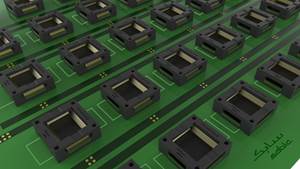Materials: PBT with High Hydrolysis Resistance and More
Lanxess’ Pocan XHR (Xtreme Hydrolysis-Resistant) PBTs offer extra benefits such as high resistance to thermal shock, hot air and chemicals.
A new line of hydrolytically-resistant PBT resin series from Lanxess, Pittsburgh, Penn., boasts outstanding resistance to hydrolytic degradation in very hot and humid conditions, along with other benefits In internal testing with standardized test specimens based on the stringent SAE/USCAR2 Rev. 6 long-term hydrolysis tests of the US Society of Automotive Engineers (SAE), the Pocan XHR (Xtreme Hydrolysis-Resistant) compounds reached Class 4 or Class 5 – the top two ratings.
Moreover, the launch of Pocan XHR has demonstrated that the additional benefits of the materials are just as important to many users, according to Ralf Heinen, application developer at Lanxess’ High-Performance Materials business unit. “They (users) often make the most of the high resistance to thermal shock, hot air, and chemicals, as well as the mechanical properties of the compounds based on polybutylene PBT).” Many electrical and electronic devices are exposed to ever-higher thermal loads for reasons including confined installation spaces or elevated operating temperatures. When used in dry environments, the plastics for these devices need to be able to withstand long periods in hot air. Heinen explains that yet another strength of Pocan XHR. For example, the impact strength of most compounds in the XHR series remains virtually unchanged even after 3,000 hours of being stored in 150 C/302 F. This makes the compounds ideal for parts in engine compartments, such as connectors, or for power electronics components.
Also, these compounds are tailor-made for overmolding of metal parts. Rapid and extreme changes in temperature often cause stress cracks in components with overmolded metal areas because of the differences between metal and plastic in terms of thermal expansion. That is why Lanxess has given the Pocan XHR series elongation at break of up to 4.7% (ISO 527-1,-2) because high elongation at break counteracts the formation of stress cracks. Moreover, the improved long-term temperature stability and hydrolysis resistance reduce susceptibility to stress cracks. Stress crack resistance is tested under extremely harsh conditions in heat shock tests. This involves subjecting the overmolded components to abrupt changes in temperature from -40 C/F to 125 C/250 F and back in several hundred cycles and keeping them at the various temperatures for extended periods--such as 30 minutes. In heat shock tests, components with Pocan XHR metal overmolding exhibit no stress cracks or, if they do, the cracks do not appear until after many multiples of the usual number of test cycles, says Heinen. That makes the XHR products exceptionally well suited to overmolding metal parts such as bus bars, connectors, power strips and main supporting frames.

Good processing characteristics of Pocan XHR are also touted. The melt viscosity of all Pocan XHR variants remains constant for a long time at the injection-molding temperatures customary for PBT. The materials remain stable during injection molding within a wide processing window. The improved flowability relative to comparable standard PBT materials makes it possible to implement thin-walled geometries. Furthermore, overmolding of metal parts can take place at lower filling pressures, which means that the metal inserts are not distorted or pushed out of position in the tool by the molten material.
Related Content
Plastic Compounding Market to Outpace Metal & Alloy Market Growth
Study shows the plastic compounding process is being used to boost electrical properties and UV resistance while custom compounding is increasingly being used to achieve high-performance in plastic-based goods.
Read MoreNew Cleanroom-Rated Static Eliminator
Neutralize static hands-free in sensitive medical, pharmaceutical and electronic manufacturing operations.
Read MoreHigh-Flow PEI ‘Captures’ Burn-In Test Socket Manufacturer
S. Korea’s Sensata is one of the first BiTS makers to adopt SABIC’s new Superflow Ultem.
Read MoreCelanese to ‘Shine’ at CES 2023 with Expanded Portfolio of Materials
With it acquisition of DuPont’s engineering resins, Celanese’s resin solutions for automotive electrification, e-mobility and consumer electronics are plentiful.
Read MoreRead Next
Beyond Prototypes: 8 Ways the Plastics Industry Is Using 3D Printing
Plastics processors are finding applications for 3D printing around the plant and across the supply chain. Here are 8 examples to look for at NPE2024.
Read MorePeople 4.0 – How to Get Buy-In from Your Staff for Industry 4.0 Systems
Implementing a production monitoring system as the foundation of a ‘smart factory’ is about integrating people with new technology as much as it is about integrating machines and computers. Here are tips from a company that has gone through the process.
Read MoreFor PLASTICS' CEO Seaholm, NPE to Shine Light on Sustainability Successes
With advocacy, communication and sustainability as three main pillars, Seaholm leads a trade association to NPE that ‘is more active today than we have ever been.’
Read More






















